Traditional Poster
Interventional MRI
ISMRM & ISMRT Annual Meeting & Exhibition • 10-15 May 2025 • Honolulu, Hawai'i

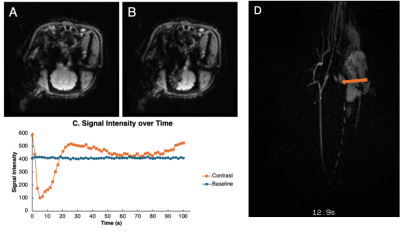 |
4835. In
vivo Feasibility of an MRI-visible Interventional Device
Portfolio for Neuro-oncology Applications
B. Kilbride, P. Su, A. Chu, D. Barry, T. Moore, K. Narsinh,
D. Cooke, A. Martin, M. Wilson, S. Hetts
University of California, San Francisco, San Francisco, United States
Impact: Successful device integration into MRI-guided
procedures enables real-time intraprocedural validation of
deposition parameters and blood-brain barrier (BBB)
permeability. Improved treatment efficacy could benefit
patients with metastatic disease or neurodegenerative
disorders requiring BBB disruption and IA therapy, among
many other applications.
|
|
 |
4836. Physics-Driven
Needle Tracking for MR-Guided Percutaneous Interventions
S. Schwieters, E. Ilia, W. Brink
University of Twente, Enschede, Netherlands
Impact: Our approach shows potential to enable smoother
guidance and increased accuracy during percutaneous
interventions.
|
|
 |
4837. Real-time
AI image reconstruction and instrument tracking in MR-guided
biopsies
S. Noordman, H. Weekenstroo, M. Maas, F. Simonis, J.
Fütterer, H. Huisman
Radboudumc, Arnhem, Netherlands
Impact: A deep-learning temporal model utilizing
spatiotemporal information achieved up to 16x undersampling
rates for MR-guided prostate biopsy scans while maintaining
accurate instrument tip positioning. This could enable
real-time instrument tracking in interventional tasks,
improving efficiency and usability.
|
|
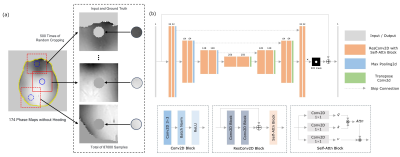 |
4838. Deep-Learning
based Referenceless MR Thermometry Using Residual U-Net with
Self-Attention
Y. Zhao, S. Zong, Q. Yang, H. Wu, G. Shen, N. J. McDannold,
C-S Mei
Shanghai Jiao Tong University, Shanghai, China
Impact:
This work enhances MR thermometry in organs with respiratory motion by achieving accurate, real-time temperature measurements and overcoming regional phase variability, demonstrating its potential for broader clinical applications in dynamic thermal assessment. |
|
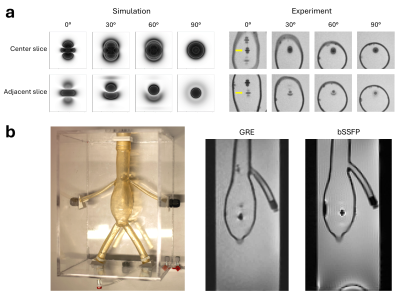 |
4839. Physics-Driven
Passive Marker Tracking for MR-Guided Endovascular Interventions
A. ter Braak, E. Ilia, M. Reinok, G. Dagnino, W. Brink
University of Twente, Enschede, Netherlands
Impact: Our physics-based approach allows for generating
large annotated training datasets for passive marker
detection, enabling robust tracking applications based on
AI. This approach can improve the robustness during
automated tracking of guidewires in MR-guided endovascular
interventions.
|
|
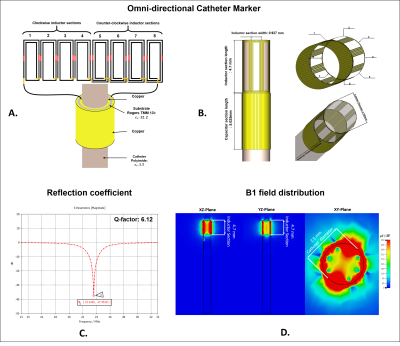 |
4840. A
Novel Omnidirectional Marker for Catheter Tracking in
endovascular MRI Applications at 0.55T
A. Bhosale, Y. Zhao, L. Ying, X. Zhang
The State University of New York at Buffalo, Buffalo, United States
Impact: This
research enhances real-time catheter tracking in MRI-guided
procedures through an innovative omnidirectional catheter
marker. Improved tracking accuracy can lead to safer
interventions and better patient outcomes, ultimately
increasing the effectiveness of interventional MRI in
diverse clinical applications.
|
|
 |
4841. Fat
fraction data-driven electrical properties digital twin model
for guiding microwave ablation planning: a preliminary study
Y. Ren, W. Ju, W. Yao, Y. Jia, X. Nan, J. Han
Anhui Medical University, Hefei, China
Impact: This approach offers a promising strategy for
customizing ablative therapy, with the promise of more
accurate patient-specific ablation predictions.
|
|
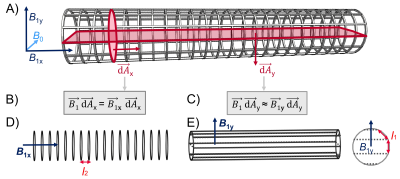 |
4842. Theoretical
and Experimental Assessment of Radiofrequency Shielding
Artifacts of Laser-cut Venous Stents
L. Regler, S. Reiss, K. Düring, W. Uller, M. Bock
Division of Medical Physics, Dept. of Diagnostic and Interventional Radiology, University Medical Center Freiburg, Faculty of Medicine, University of Freiburg, Freiburg, Germany, Freiburg, Germany
Impact: This work provides a fundamental method to
calculate RF-induced shielding from stent geometries. For
laser-cut vein stents this information can be used to
calculate the optimal excitation flip angle, or to modify
the stent geometry to improve the in-stent luminosity.
|
|
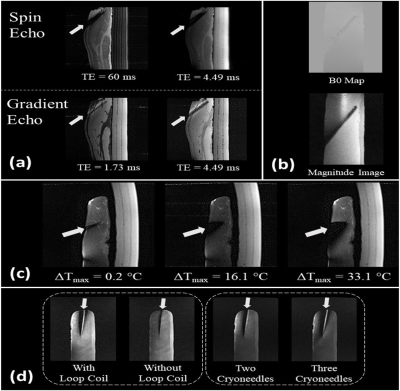 |
4843. Contributing
factors and mitigation strategies of the cryoprobe-induced
artifacts during MRI-guided cryoablation procedures
A. Lu, S. Thompson, D. Adamo, D. Woodrum
Mayo Clinic, Rochester, United States
Impact: Applicators used in MRI-guided ablations can
introduce artifacts that compromise the accuracy of the
needle placement and treatment monitoring. Understanding
the artifact sources and identify mitigation strategies is
critical to improve the treatment efficacy.
|
|
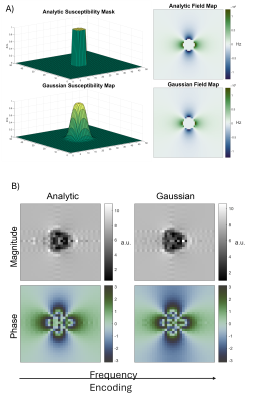 |
4844. Differentiable
Image-Based Needle Localization in MR-Guided Interventions
S. Garrow, W. Grissom
Case Western Reserve University, Cleveland, United States
Impact: Accurate needle localization is key to the
safety and efficacy of interventional MR procedures. The
proposed differentiable image-based method recovers needle
position and pose accurately, regardless of needle-induced
image distortions.
|
|
 |
4845. Safety
and efficacy of MR-guided low intensity transcranial ultrasound
stimulation for depression
X. Cai, W. Sun, X. Zheng, N. Ding, Y. Liu, D. Meng, B. Yuan,
X. Long
Shenzhen Samii Medical Center, Shenzhen, China
Impact: This study introduces a non-invasive MR-guided
ultrasound therapy that effectively alleviates depression
symptoms, marking a significant step forward in mental
health treatment.
|
|
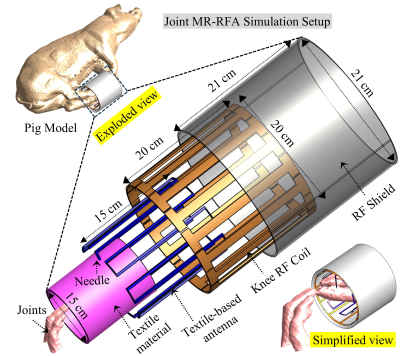 |
4846. Assessment
of 7-Tesla Magnetic Resonance Mediated Radiofrequency Ablation
in Pig Joint Using Textile Monopole Antenna
S. Ullah, S. Oh, H. Yoo
Northwestern University, Chicago, United States
Impact: In contrast to existing ablation designs which
requires ground pads, this design for the pig knee joint
delivers localized heating, minimizes tissue damage, no MR
image distortion, and eliminates the need for external RF
power sources.
|
|
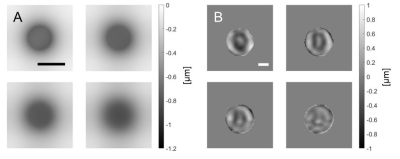 |
4847. Magnetic
resonance acoustic radiation force imaging of deformations
induced by acoustic holograms
R. Willoughby
University of Alabama at Birmingham, Birmingham, United States
Impact: This study shows that MR-ARFI may be suitable
for precise guidance of therapeutic mechanical stimulation
by measuring the microscopic deformation of tissue induced
by ultrasonic holograms.
|
|
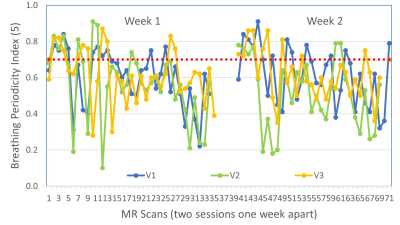 |
4848. Short
and long-term breathing irregularities in MR navigator and
bellow surrogates and enhancement of external-internal motion
correlation
A. Milewski, C. Wu, Y. Liu, V. Yu, J. Smink, R. Jafari, G.
Li
Memorial Sloan Kettering Cancer Center, New York, United States
Impact: Both short-term and long-term respiratory
irregularities were characterized. Keeping subjects awake
through communication reduced irregularities and increased
gating efficiency. Additionally, phase-shift correction
improved the external-internal motion correlation,
suggesting a higher fidelity in 4D-imaging surrogates and
better internal motion prediction.
|
|
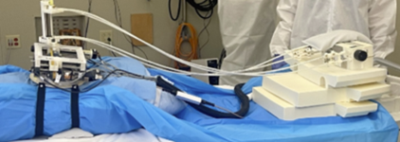 |
4849. Development
and Evaluation of an MRI-Guided Robotic System for Sacroiliac
Joint Injections
W. Loew, R. Monfaredi, G. Li, C. Dumoulin, I. Iordachita, K.
Sharma, K. Cleary
Cincinnati Children's Hospital Medical Center, Cincinnati, United States
Impact: Minimally invasive injections through small
needles are an essential tool in pain management for the
diagnosis and treatment of chronic pain. High success
requires good visualization of the targeted nerve and
accurate needle placement which MRI-guided robotic
intervention will provide.
|
|
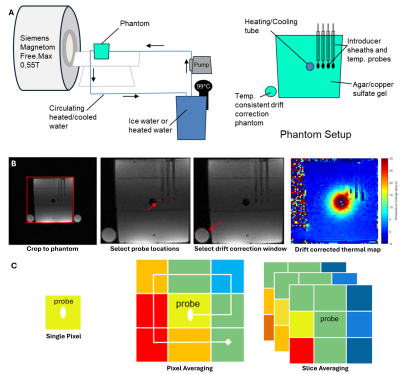 |
4850. Assessment
of Real-Time PRFS Thermometry Feasibility and Accuracy at 0.55 T
for Interventional Ablation Procedures and MRI Safety
L. Schepers, A. Ahmed, E. Anttila, N. Ooms, J. Roll, W.
Majeed, A. Krafft, F. Maier, H. B. Unal, B. Sharif, D. Gross
MED Institute, West Lafayette, United States
Impact: This study explored the accuracy of thermometry
at 0.55T in simple homogenous phantoms while looking ahead
to implementation in iMRI applications. Thermometry at 0.55T
has potential for real-time temperature monitoring with a
clinically relevant degree of accuracy.
|
|
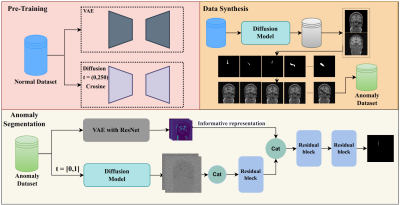 |
4851. Unsupervised
anomaly detection based on diffusion models for needle detection
in MR-guided interventions
L. Guo, T. Guo, L. Chen, B. Qiu
University of Science and Technology of China, Hefei, Anhui, China
Impact: The proposed method is noise-robust and
insensitive to shape characteristics, has the potential to
be applied in real-time interventional magnetic resonance
imaging (i-MRI)
|
|
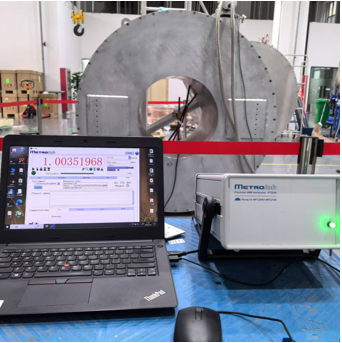 |
4852. 1.0T
ultra-short cavity superconducting magnet design for
intraoperative magnetic resonance
q. zhang, y. xie, p. wang, h. du, y. zhou, l. chen, b. qiu
Medical Imaging Center, Department of Electronic Engineering and Information Science, University of Science and Technology of China, Hefei, Anhui 230026, China, hefei, China
Impact: The ultra-short cavity superconducting magnet
makes intraoperative magnetic resonance real-time imaging
possible and improves surgical accuracy.
|
|
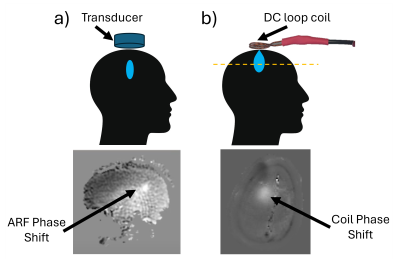 |
4853. Mimicking
Transcranial Focused Ultrasound with a DC Loop Coil for
Repeatable and Safe Development of Acoustic Radiation Force
Imaging Methods
K. Zarcone, A. Sharma, W. Grissom
Case Western Reserve University, Cleveland, United States
Impact: MR-ARFI has the potential to guide ultrasound
neuromodulation, but its development is hindered by
reproducibility and regulatory challenges. We used a DC loop
coil to mimic the phase shifts produced by ultrasound in
MR-ARFI, to enable MR-ARFI development in vivo.
|
|
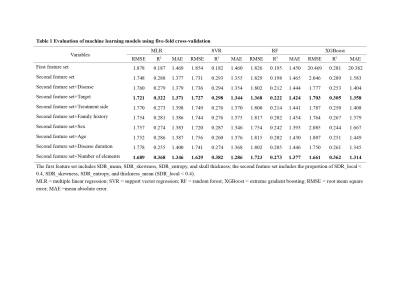 |
4854. Predictive
Value of Skull-Related Parameters on Maximum Temperature During
MRgFUS in Parkinson's Disease and Essential Tremor
H. Lu, Y. Xiong, X. Lou
The First Medical Center of PLA General Hospital, Beijing, China
Impact: In this study, we found that indicators of local
skull characteristics were able to predict maximum
temperature more accurately, which contributes to
preoperative patient screening.
|
The International Society for Magnetic Resonance in Medicine is accredited by the Accreditation Council for Continuing Medical Education to provide continuing medical education for physicians.